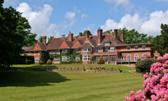The 25 Richest People Who Ever Lived – Inflation Adjusted
Random Celebrity Article By Brian Warner on October 13, 2012In addition to some familiar modern names like Bill Gates and Warren Buffett, our list features older magnates like Vanderbilt and Carnegie. We also included lesser known billionaires from history that you may have never even heard of before. We guarantee the #1 person on this list will make your jaw drop.
Fun Facts About The Richest People Who Ever Lived:
- 1) These billionaires control a combined $4.317 trillion!
- 2) The richest people ever are all men. Sadly No women cracked the top 25.
- 3) 14 out of the 25 people are Americans.
- 4) Bill Gates is the richest American and the richest person still alive on this list.
- 5) Carlos Slim Helu, the current richest person in the world, did not even crack the top 20.
The 30 Richest Americans Of All Time – Inflation Adjusted
The 20 Richest People in the World 2012
The 25 Richest People of All Time
- #1 Mansa Musa I – Net Worth $400 Billion
- #2 The Rothschild Family – $350 Billion
- #3 John D. Rockefeller – Net Worth $340 Billion
- #4 Andrew Carnegie – Net Worth $310 Billion
- #5 Nikolai Alexandrovich Romanov – Net Worth $300 Billion
- #6 Mir Osman Ali Khan – Net Worth $230 billion
- #7 William The Conqueror – Net Worth $229.5 Billion
- #8 Muammar Gaddafi – Net Worth $200 Billion
- #9 Henry Ford – Net Worth $199 Billion
- #10 Cornelius Vanderbilt – Net Worth $185 Billion
- #11 Alan Rufus – $178.65 billion
- #12 Bill Gates – Net Worth $136 Billion
- #13 William de Warenne – Net Worth $147.13 Billion
- #14 John Jacob Astor – Net Worth $121 Billion
- #15 Richard Fitzalan 10th Earl of Arundel – Net Worth $118.6 Billion
- #16 John of Gaunt – Net Worth $110 Billion
- #17 Stephen Girard – Net Worth $105 Billion
- #18 A.T. Stewart – Net Wort $90 Billion
- #19 Henry Duke of Lancaster – Net Worth $85.1 Billion
- #20 Friedrich Weyerhauser – Net Worth $80 Billion
- #21 Jay Gould – Net Worth $71 Billion
- #22 Carlos Slim Helu – Net Worth $68 Billion
- #22 Stephen Van Rensselaer – Net Worth $68 Billion
- #23 Marshall Field – Net Worth $66 Billion
- #24 Sam Walton – Net Worth $65 Billion
- #25 Warren Buffett – Net Worth $64 Billion
Related Articles
- The Richest American Presidents Of All Time - Inflation Adjusted
- The 15 Richest Heads of State
- Was Muammar Gaddafi The Richest Person Ever? Worth $200 Billion?
- Saudi Billionaire Throws Money On Woman Trying to Sing
- Dr Jerry Buss Net Worth
The 25 Richest People Who Ever Lived – Inflation Adjusted Videos
-

Secrets Of The Richest Man Who Ever Lived. - YouTube
Secrets of The Richest Man Who Ever Lived. Derek Kilpatrick13 videos ...
-

Proverbs Experiment: Insight From Richest Man Who ...
http:lulu.comspotlightraquelsoto Insight from King Solomon, the richest man who ever lived ...
-

#19 - Where The Rich People Live - YouTube
How Rich People Park: Man Parks His Lamborghini in his Living Room!by YHJJ1 5,410 views ...
Mansa Musa I of Mali was the 1st Richest Man known on Earth
From Wikipedia, the free encyclopedia
(Redirected from Musa
(mansa))
| Mansa Musa | |
|---|---|
 | |
| Musa depicted holding a gold nugget from the 1375 Catalan Atlas. | |
| Reign | c. 1312 - 1337 |
| Spouse | Inari Kunate |
| Born | ca. 1280's Mali |
| Died | ca. 1337 |
| Occupation | Emperor of the Malian Empire |
| Religion | Islam |
Nomenclature
Musa was referred to and is most commonly found as Mansa Musa in Western manuscripts and literature. His name also appears as Kankou Musa, Kankan Musa or Kanku Musa which means "Musa, son of Kankou", where Kankou is the name of his mother. Other alternatives go on as Mali-koy Kankan Musa, Gonga Musa and the Lion of Mali.[2][3]
[edit] Lineage and accession to the throne
What is known about the kings of the Malian Empire is taken from the writings of Arab scholars, including Al-Umari, Abu-sa'id Uthman ad-Dukkali, Ibn Khaldun, and Ibn Battuta. According to Ibn-Khaldun's comprehensive history of the Malian kings, Mansa Musa's grandfather was Abu-Bakr (the Arabic equivalent to Bakari or Bogari, original name unknown - not the sahabiyy Abu Bakr), a brother of Sundiata Keita, the founder of the Malian Empire as recorded through oral histories. Abu-Bakr did not ascend the throne, and his son, Musa's father, Faga Laye, has no significance in the History of Mali.[4]Mansa Musa came to the throne through a practice of appointing a deputy when a king goes on his pilgrimage to Mecca or some other endeavor, and later naming the deputy as heir. According to primary sources, Musa was appointed deputy of the king before him, who had reportedly embarked on an expedition to explore the limits of the Atlantic ocean, and never returned. The Arab-Egyptian scholar Al-Umari quotes Mansa Musa as follows:
Musa's son and successor, Mansa Magha, was also appointed deputy during Musa's pilgrimage.[6]The ruler who preceded me did not believe that it was impossible to reach the extremity of the ocean that encircles the earth (meaning the Atlantic). He wanted to reach that (end) and was determined to pursue his plan. So he equipped two hundred boats full of men, and many others full of gold, water and provisions sufficient for several years. He ordered the captain not to return until they had reached the other end of the ocean, or until he had exhausted the provisions and water. So they set out on their journey. They were absent for a long period, and, at last just one boat returned. When questioned the captain replied: 'O Prince, we navigated for a long period, until we saw in the midst of the ocean a great river which flowing massively. My boat was the last one; others were ahead of me, and they were drowned in the great whirlpool and never came out again. I sailed back to escape this current.' But the Sultan would not believe him. He ordered two thousand boats to be equipped for him and his men, and one thousand more for water and provisions. Then he conferred the regency on me for the term of his absence, and departed with his men, never to return nor to give a sign of life.—Mansa Musa[5]
[edit] Islam and pilgrimage to Mecca
From the far reaches of the Mediterranean Sea to
the Indus
River, the faithful approached the city of Mecca. All had the same objective
to worship together at the most sacred shrine of Islam, the Kaaba in Mecca. One such traveler was Mansa Musa, Sultan of Mali in Western Africa. Mansa Musa
had prepared carefully for the long journey he and his attendants would take. He
was determined to travel not only for his own religious fulfillment, but also
for recruiting teachers and leaders, so that his realms could learn more of the
Prophet's
teachings.
Mahmud Kati, Chronicle of the
Seeker
Musa made his pilgrimage in 1324, his procession reported to include 60,000 men, 12,000 slaves who each carried 4-lb. gold bars, heralds dressed in silks who bore gold staffs, organized horses and handled bags. Musa provided all necessities for the procession, feeding the entire company of men and animals.[8] Also in the train were 80 camels, which varying reports claim carried between 50 and 300 pounds of gold dust each. He gave away the gold to the poor he met along his route. Musa not only gave to the cities he passed on the way to Mecca, including Cairo and Medina, but also traded gold for souvenirs. Furthermore, it has been recorded that he built a mosque each and every Friday.
Musa's journey was documented by several eyewitnesses along his route, who were in awe of his wealth and extensive procession, and records exist in a variety of sources, including journals, oral accounts and histories. Musa is known to have visited with the Mamluk sultan Al-Nasir Muhammad of Egypt in July 1324.[9]
Musa's generous actions, however, inadvertently devastated the economy of the region. In the cities of Cairo, Medina and Mecca, the sudden influx of gold devalued the metal for the next decade. Prices on goods and wares super inflated in an attempt to adjust to the newfound wealth that was spreading throughout local populations. To rectify the gold market, Musa borrowed all the gold he could carry from money-lenders in Cairo, at high interest. This is the only time recorded in history that one man directly controlled the price of gold in the Mediterranean.[10]
[edit] Later reign
Whenever a hero adds to the list of his exploits from conquest, Mansa Musa
gives them a pair of wide trousers...The greater the number of a Dogari's
exploits, the bigger the size of his trousers.
[edit] Construction in Mali
Musa embarked on a large building program, raising mosques and madrasas in Timbuktu and Gao. Most famously the ancient center of learning Sankore Madrasah or University of Sankore was constructed during his reign. In Niani, he built the Hall of Audience, a building communicated by an interior door to the royal palace. It was "an admirable Monument" surmounted by a dome, adorned with arabesques of striking colours. The windows of an upper floor were plated with wood and framed in silver foil, those of a lower floor were plated with wood, framed in gold. Like the Great Mosque, a contemporaneous and grandiose structure in Timbuktu, the Hall was built of cut stone.During this period, there was an advanced level of urban living in the major centers of the Mali. Sergio Domian, an Italian art and architecture scholar, wrote the following about this period: "Thus was laid the foundation of an urban civilization. At the height of its power, Mali had at least 400 cities, and the interior of the Niger Delta was very densely populated."[12]
[edit] Influence in Timbuktu
It is recorded that Mansa Musa traveled through the cities of Timbuktu and Gao on his way to Mecca, and made them a part of his empire when he returned around 1325. He brought architects from Andalusia, a region in Spain, and Cairo to build his grand palace in Timbuktu and the great Djinguereber Mosque that still stands today.[13]Timbuktu soon became a center of trade, culture, and Islam; markets brought in merchants from Hausaland, Egypt, and other African kingdoms, a university was founded in the city (as well as in the Malian cities of Djenné and Ségou), and Islam was spread through the markets and university, making Timbuktu a new area for Islamic scholarship.[14] News of the Malian empire’s city of wealth even traveled across the Mediterranean to southern Europe, where traders from Venice, Granada, and Genoa soon added Timbuktu to their maps to trade manufactured goods for gold.[15]
The University of Sankore in Timbuktu was restaffed under Musa's reign, with jurists, astronomers, and mathematicians.[16] The university became a center of learning and culture, drawing Muslim scholars from around Africa and the Middle East to Timbuktu.
In 1330, the kingdom of Mossi invaded and conquered the city of Timbuktu. Gao had already been captured by Musa's general, and Musa quickly regained Timbuktu and built a rampart and stone fort, and placed a standing army, to protect the city from future invaders.[17]
While Musa’s palace has since vanished, the university and mosque still stand in Timbuktu today.










No comments:
Post a Comment